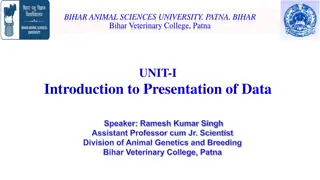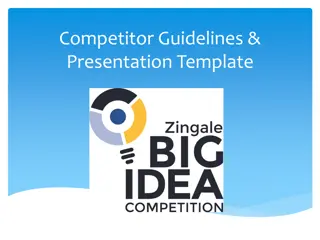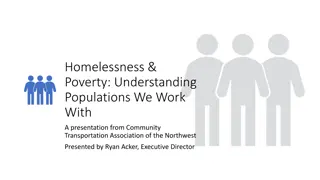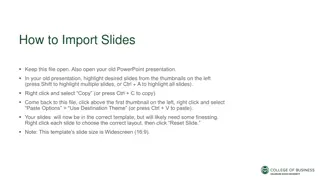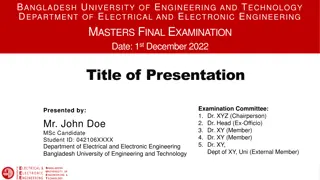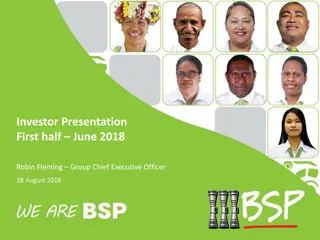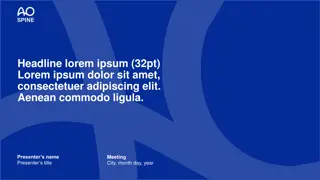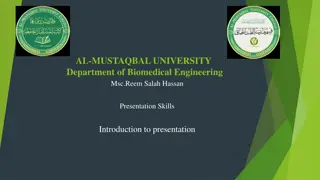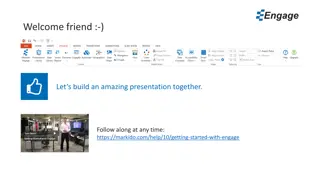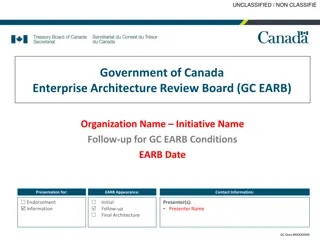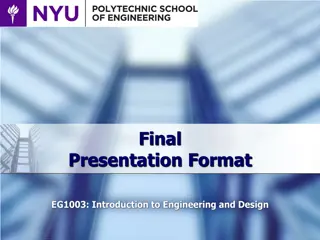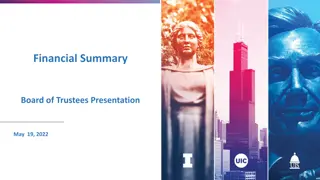
Understanding USAID Grants: A Comprehensive Guide
Join Sheena Agarwal and Hamid Mehmood in this detailed workshop on USAID grants, covering types of grants, regulatory framework, lifecycle, ethical considerations, and practical exercises. Learn about regulations, compliance requirements, grant award cycles, and more.
Download Presentation

Please find below an Image/Link to download the presentation.
The content on the website is provided AS IS for your information and personal use only. It may not be sold, licensed, or shared on other websites without obtaining consent from the author. If you encounter any issues during the download, it is possible that the publisher has removed the file from their server.
You are allowed to download the files provided on this website for personal or commercial use, subject to the condition that they are used lawfully. All files are the property of their respective owners.
The content on the website is provided AS IS for your information and personal use only. It may not be sold, licensed, or shared on other websites without obtaining consent from the author.
E N D
Presentation Transcript
1 Introduction to USAID Grants Facilitated by: Sheena Agarwal and Hamid Mehmood August 26, 2016
2 Objectives Familiarize participants with USAID grants Discuss the types of grants and regulatory framework Provide an overview of the grants lifecycle Identify and discuss ethical considerations in grants management Do a hands-on case study exercise to practice concepts
What you will learn Regulations, standards, USAID vocabulary, grants framework Compliance requirements What a grant award cycle entails How to complete some sections of a solicitation, and evaluate how well a submission aligns with an RFA (Request for Applications)
Introduction: Participants 4 Name Organization Your Role Any USAID grant experience or other donors?
Agenda 5 8:30-9:00 9:00-9:30 9:30-10:15 10:15-10:30 10:30-10:45 Introduction and Objectives Part I - Understanding the USAID grant framework Part II - Grant life cycle RFAs and Concept Papers - What to expect Tea/Coffee break Part III - Case Study/Group Exercise - Creating an activity plan and Gantt chart for a solicitation Discussion/Feedback on exercise Lunch Part IV - Internal Controls, Ethics and Standards of Business Conduct Part V - Case study/group exercise - Creating a budget for a solicitation Tea/Coffee break Discussion/Feedback on exercise Wrap up/Closing 10:45-12:00 12:00 - 12:30 12:30 - 1:30 1:30 - 2:30 2:30 - 3:45 3:45-4:15 4:15-5:00 5:00 - 5:30
Introduction: SERVIR-Mekong 6 USAID/NASA Partnership (2014-2019) Goal: To enhance climate change adaptation and landscape management in the Lower Mekong region through the increased application of geospatial analysis to policy and planning needs Consortium Spatial Informatics Group Stockholm Environment Institute Deltares
7 SERVIR-Mekong Small Grants Program Launching: September 2016
8 Servir.adpc.net Launching August 30th
What is USAID? 9 Mission Statement: USAID partners to end extreme poverty and promote resilient, democratic societies while advancing US security and prosperity. USAID provides assistance in sub-Saharan Africa, Asia and the Near East, Latin America and the Caribbean, and Europe and Eurasia. With headquarters in Washington, D.C., USAID s strength is its field offices in many regions of the world.
10 Where does USAID work?
What is a USAID grant? 11 Grants are financial assistance providing support or stimulation to accomplish a public (project) purpose, consistent with grantee s mandate Distinguishing Features: Governed by specific set of regulations Relationship is one of sponsorship Should be performance-based Often entails capacity building
Types of Assistance 12 Cooperative Agreements Grants Contracts Difference between a Direct Grant and Grant Under Contract (GUC) Main difference is a cooperative agreement may have substantial involvement on the part of USAID (ex. Approvals)
Grant Types 13 Fixed Award Amount Simplified Standard In-Kind
Grant Types 14 Fixed Award Amount Simplified Standard In-Kind Max $150,000 USD per grant, no limit on duration Advances or reimbursement No international airfare (exceptions) No indirect costs Equipment only if necessary No construction Max $500,000/year, 3 years ($1.5m) Normally shorter duration Fixed tranche payments upon achievement of milestones Accomplishments clear and discernible Low risk and management burden; Requires more up-front work No construction No max amount or duration Advances or reimbursement May include int l travel, indirect costs Increased grantee financial and reporting requirements --- high risk for project No construction No max amount or duration Can be portion of any grant type, or 100% in-kind grant Not an official grant type Pre-award risk assessment required, but less extensive No construction
Different types of payment methods 15 Fixed Award Amount Simplified Standard In-Kind Periodic reimbursements based on submission of receipts Fixed amount tranche payments based on achievement of milestones (no receipts) Periodic advances and/or reimbursements (receipts) Direct Payment to Vendor
Eligibility Requirements 16 Applicants must be a registered organization Demonstrate successful past performance in implementation Display sound management in the form of financial, administrative, and technical policies and procedures and present a system of internal controls that safeguard assets Government entities cannot receive direct financial compensation
USAID Regulatory Framework 17 Statute (Law) Foreign Assistance Act of 1961 Federal Grant and Cooperative Agreement Act of 1977 Regulatory Framework Administrative Rules and Regulations 22 CFR 200 (used to be OMB A-110, A-122, A-133) 22 CFR 226 USAID Policies & Procedures ADS 303 Standard Provisions Grant Agreement Terms and conditions
ADS 303 - Grants and Cooperative Agreements to Non-Governmental Organizations 18 USAID specific policy Provides comprehensive guide for grants programs Provides a comprehensive guide for grants programs Defines policies, procedures, and standards that USAID applies to its grant making activities As a grantee, everyone must base their grants making on the guidance found in ADS 303
19 Mandatory Standard Provisions M1. Allowable Costs M2. Accounting, Audit, and Records M3. Amendment of Award and Revision of Budget M4. Notices M5. Procurement Policies M6. USAID Eligibility Rules for Procurement of Commodities and Services M7. Title To and Use of Property M8. Development Experience Clearinghouse and Data Rights M9. Public Communications M10. Termination and Suspension M11. Recipient and Employee Conduct M12. Debarment and Suspension M13. Disputes and Appeals M14. Preventing Terrorist Financing M15. Trafficking in Persons M16. Voluntary Population Planning M17. Equal Participation by Faith-Based Organizations M18. Non-Discrimination M19. USAID Disability Policy M20. Limiting Construction Activities
Grant funds may not be used for the following: 21 Construction or infrastructure activities of any kind. Ceremonies, parties, celebrations, or representation expenses. Purchases of restricted goods, such as: restricted agricultural commodities, motor vehicles including motorcycles, pharmaceuticals, medical equipment, contraceptive products, used equipment; without the previous approval of SERVIR, or prohibited goods, prohibited goods under USAID regulations, including but not limited to the following: abortion equipment and services, luxury goods, etc. Alcoholic beverages. Purchases of goods or services restricted or prohibited under the prevailing USAID source/ nationality regulations. Any purchase or activity, which has already been made. Purchases or activities unnecessary to accomplish grant purposes as determined by SERVIR. Prior obligations of and/or, debts, fines, and penalties imposed on the Grantee. Creation of endowments.
22 Part 2 Grants Lifecycle
Grants lifecycle 23 Solicitation Close-out Evaluation Implementation Negotiations Pre-award Assessment Award
Solicitation 24 What is included in a solicitation Program description Eligibility Pre-award assessment for sound controls/financial ability/etc Instructions Award information (estimates on $ and timeline) Regulations Annexes
Evaluation 25 Internal review by the project staff issuing the grant Basic criteria will be established in the RFA/Concept Paper
Due Diligence 26 Conduct pre-award assessment Negotiate final budget Verify costs
Negotiations 27 Negotiations on budget and terms Sign required certifications
Pre-Award Responsibility Determination Non-U.S. Organization Pre-Award Survey (NUPAS) 28 NUPAS Objectives: Determine whether the organization has sufficient financial and managerial capacity to manage USAID funds in accordance with U.S. Government and USAID requirements Determine the most appropriate method of financing Determine the degree of support and oversight necessary to ensure proper accountability of funds Capacity and risk areas to review : Legal Structure Financial management and internal control systems Procurement systems Human Resources Project Performance Management
Award 29 Solicitation Close-out Evaluation Important items to look for in your award Signatures Points of contact Implementation Negotiations Term of the activity Objective of the activity Pre-award Assessment Reporting requirements/deadlines Award Budget Payment Terms Special considerations who is going to do the procurement, are there any specific approvals needed, branding and marking, termination clauses, etc.
Implementation 30 Understand your activity and follow your activity plan Progress reports Financial terms for payment based on type of grant Project management What to do if you cannot meet your deliverable or terms per your agreement Procurements or activities are delayed Mid-cycle modifications M&E
Closeout 31 Technical Closeout Activities have been completed in accordance with the work plan/activity plan Financial Closeout Final reconciliation of any advanced funds or expenditures under the award submitted Regulatory Closeout Files and records have been properly maintained for audit purposes
Grant Cycle Exercise 32 Work in groups to put the stages of a grant in the correct order
RFAs/Concept Papers 33 What does it mean to be responsive to a solicitation??
Part III: Case Study/Group Exercise 35 Creating an activity plan and Gantt chart for a solicitation
37 Part IV: Internal Controls, Ethics and Standards of Business Conduct
Ethics, Compliance and Internal Controls 38 Internal Controls/Segregation of duties Standards of Business Conduct Anti-Kickback Conflict of Interest False Claims Act Employee Whistleblower Rights
What does internal controls mean? 39 An organization s management environment should have: Effective and efficient Operations Compliance with terms, conditions and regulations Reliable Financial Reporting
Seven Essential Elements of Internal Controls 40 What are the seven essential elements of a good system of internal controls? Competent Personnel Monitoring Fixed Periodic Reporting Responsibilities Reliable Accounting System Segregation of Duties Safeguards Over Assets
Roles & Responsibilities 41 Grant Manager Grant Grant Finance staff Technical Staff
Segregation of Duties 42 Approver Payer Receiver
Complete and Truthful Records 43 How can you do this? Record work time, expenses for travel, materials, and quotes for goods and services completely and accurately. Never alter or create financial documents such as receipts or invoices to conceal, exaggerate, or falsify information.
44 Example: Timesheets You cannot submit and approve your own timesheet Match your time to what you actually worked for the grant activity only (non-related work cannot be included in what you bill for your grant) If you think you may exceed the budgeted hours, talk to the grant manager/donor BEFORE you incur the cost Bill only up to 8 hours a day and 5 days a week
Example: Fair and Healthy Competition 45 Take every measure to do excellent work and provide competent service. Restrict doing business with companies that participate in anti- competitive business practices, such as: A supplier submitting a fake bid, so its bid is the lowest Companies colluding on prices, like taking turns submitting a low bid A bid or offer from a company that does not exist
Standards of Business Conduct 46 Your organization should have formal standards (on paper) of conduct or other policies and practices that reflect your commitments to each other and your business partners. It is required by USAID but it is also important to other donors Being a reliable partner to your client and partners Maintain accurate and transparent records and accounts Creating a culture of honesty and respect Think carefully before giving or accepting business favors Avoid conflicts of interest Promote fair and healthy competition
What types of things must be disclosed to a donor? 47 Any employment relationship (including self- employment) you maintain in addition to employment by the project. Any outside business relationship or affiliation that may do business with the project or in your project s country. A financial or management interest in any company that provides goods or services to the project or that will be a project client. WRITE THIS INTO YOUR POLICIES!!
Kickbacks 48 Accepting $ or gifts from current or future vendors
Kickback Case Studies 49 Are these cases okay? A vendor provides your staff member with a laptop as a gift after receiving a quotation. A subawardee asks a vendor for payment in order for vendor to be awarded the bid. Using a recurring hotel and the hotel provides a voucher during the holiday season as a gift.
Conflict of Interest 50 When an employee is in a position where their personal or professional interests interfere with their objective decision making for the institution If this is the case, you must openly acknowledge and report these conflicting interests




